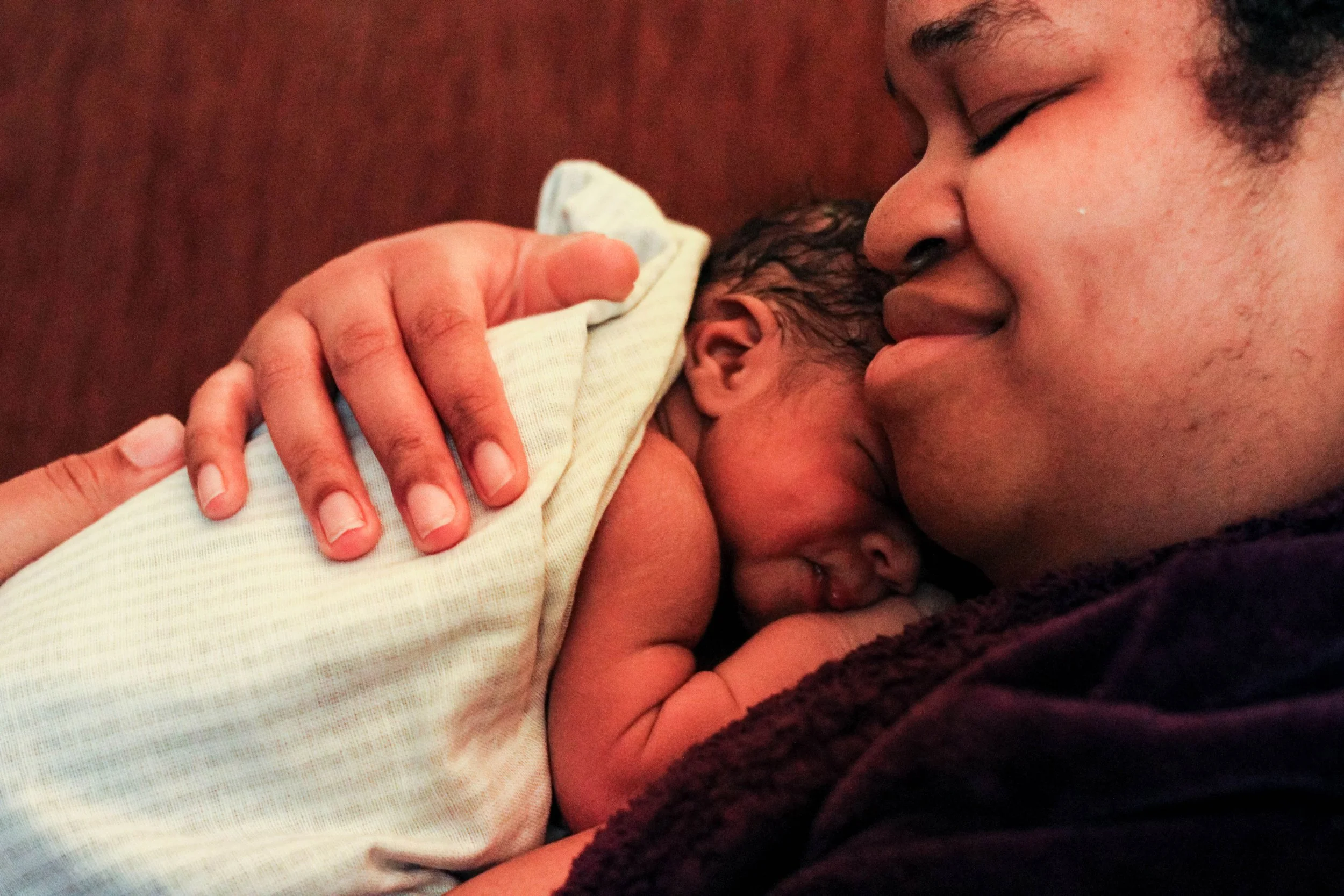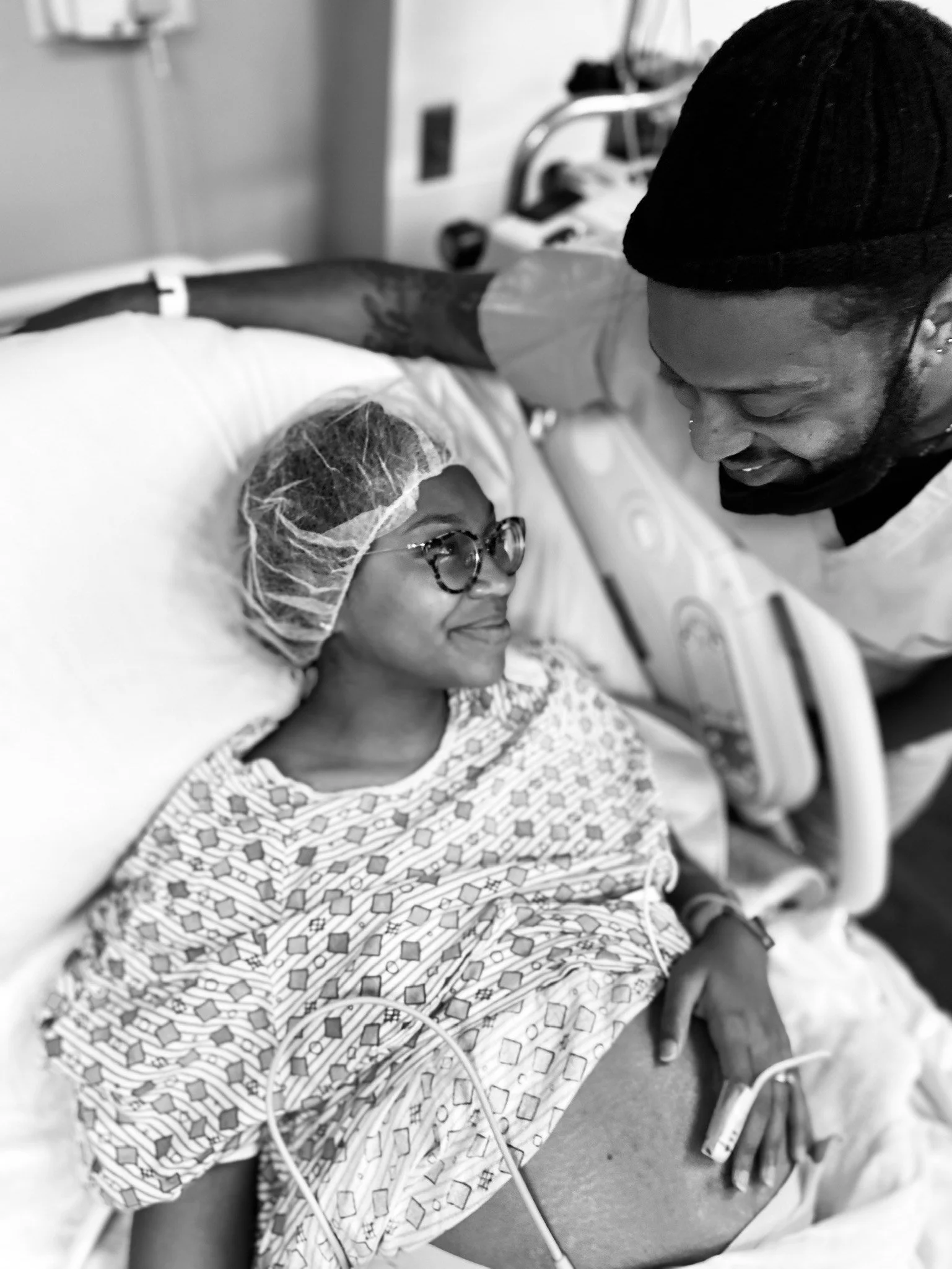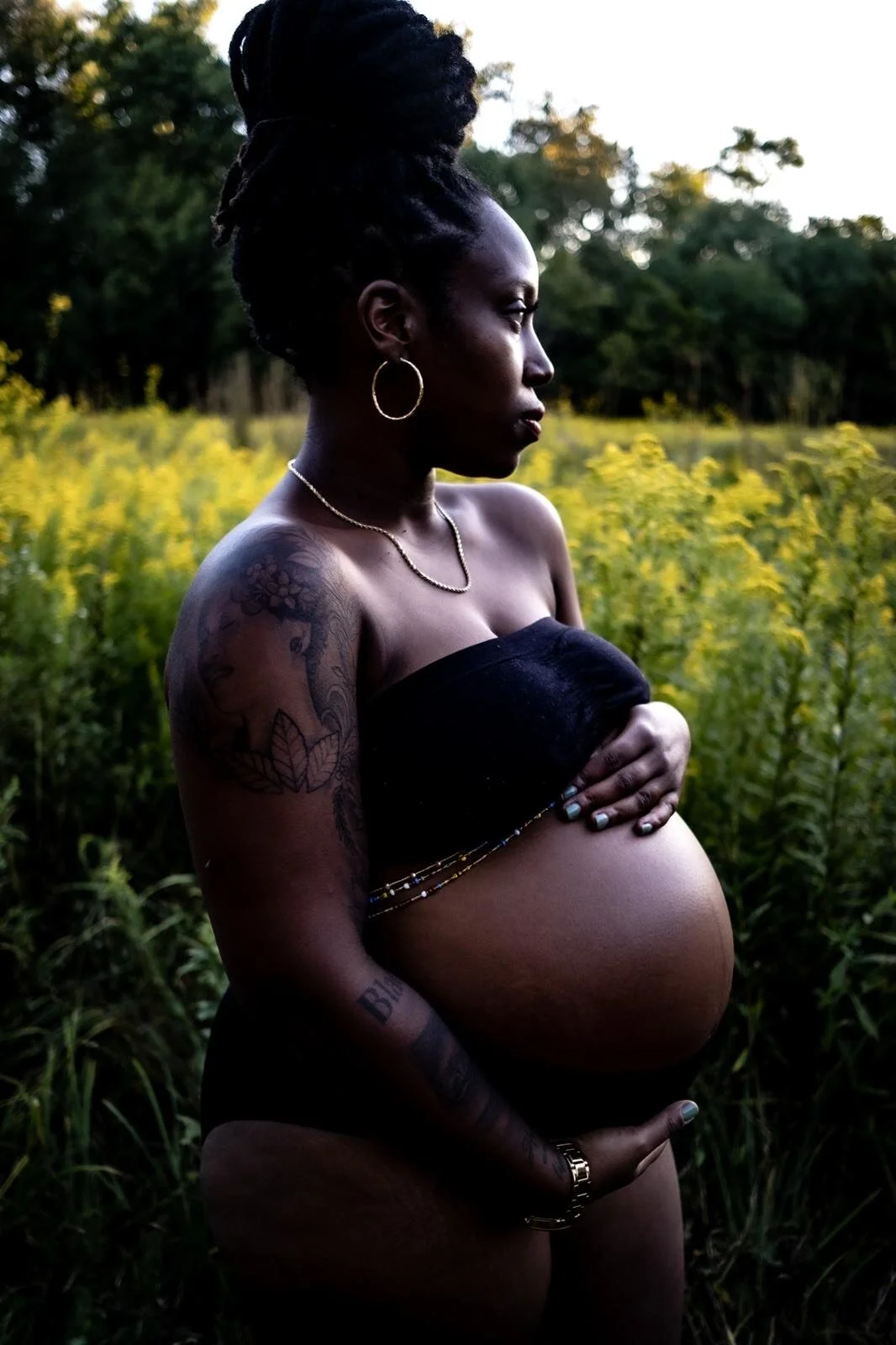Fear and triumph are two words that Ashlee Grant uses to describe her collective birthing experiences. She would navigate the uneasiness of a first pregnancy after miscarriage culminating in a surgical birth of her and her husband's choosing, solidifying their bond as partners. She found the still, small voice that strengthened their resolve.
Ashlee entered the second pregnancy as a new version of herself. She had found her voice after coming to grips with previous trauma and made space to process the layers of her first birth. A deepened knowledge of her body and spirit's needs deepened as her second son grew. She would again seek the support of her sister-in-law as her doula; this time, they had both grown and prepared to bring Ashlee's vision to life. Her doula was now working with ROOTT and had added more perinatal education to her skillset. Complications with the pandemic's beginning presented uncertainty as Ashlee and her husband, Jerod, considered how they would manage if their doula were not present. Thankfully labor would ensue before the hospital's temporary ban on doulas would start.
Ashlee labored at home with her family and doula as planned. The atmosphere was peaceful and undisturbed. They would leave for the hospital when the contractions (surges) were three minutes apart. She arrived in triage and consented to a cervical check that revealed she was 4cm dilated. Instantly defeated and whisked back to the same progression of her first labor Ashlee could feel a shift in her demeanor. Her doula quickly reminded her that it wasn't the same, her body was doing the work, and she would birth the way she wanted to this time. The redirection allowed her to connect to the present and continue balancing movement and rest in the labor room. She had the birth she wanted, delivering a healthy second son, this time without the epidural and minimal interventions.
Today, Ashlee encourages women to find their voices, seek support, and be their own best advocates. She is the host of her own self-coined "preachcast," Planted, where she speaks to the heart of women and opens their eyes to their unique gifting.
Read More“It’s not the baby. It’s you.” These are the words that Jennifer Walton would hear from her medical provider as he determined with a quick cervical check that she would need to deliver her baby via surgical birth. In fact, he later told her that she would never be able to deliver vaginally because a baby couldn’t fit through her pelvis. Jennifer didn’t want a c-section and made that clear to her provider. But the cascade of interventions and the lack of informed consent would send them into a spiral that left little room to catch up mentally to what was about to happen to Jennifer physically. There had been no complications or concerns, but a lull in labor would drastically alter Jennifer and her husband, Sean’s plans. Their first baby would be born healthy and strong, but the surgical birth trauma would linger into their postpartum world.
The Walton’s welcomed their second pregnancy with a young toddler to care for. Jennifer was determined that this birth would be different. The first pregnancy had been easy, and they had the rug pulled from under them in the twilight hours of labor. Jennifer was different; she had been fire tested and was prepared to put in the work to change the narrative that had been created about her body. The weight of her previous provider’s words was pressed into her psyche. She knew that she wanted a VBAC and stacked the deck to support her goal. Jennifer selected a new OB/GYN; she was a Black woman and made her feel supported and heard. Her friend introduced her to the term doula, and where she could find one, She connected with her perinatal support doula, Jessica Roach, at Restoring Our Own Through Transformation (ROOTT). ROOTT is a collective of concerned Black families, community members, advocates & interdisciplinary professionals dedicated to decreasing Black maternal & infant mortality in Ohio. The heart of their work is the commitment and rigorous training of their perinatal support doulas. Jessica educated her about her rights as a patient, guided her family through a healthy pregnancy, and helped strengthen their resolve for Jennifer to deliver their baby vaginally.
The fear of a uterine rupture would still linger in her mind, but with the support of her birth team, she moved forward with planning her VBAC. Jennifer recalled Jessica’s words in the midst of laboring at home, “Stop fighting your body and let this thing happen.” She did stop fighting her body. She let go of the defeating messages from her first pregnancy, surrendered to the process, and found her voice and strength. She gave birth to another healthy and strong daughter, accomplishing her VBAC.
Read MoreFor Ivory and Ernest a previous miscarriage had introduced a fear of pregnancy loss that loomed for a while. Their healing has enabled them to share their story with grace and humility. As the pregnancy thrived, Ivory and Ernest began to manage and prepare for childbirth. They hired a ROOTT perinatal support doula to support their pregnancy. They were able to start working with their doula in the critical stages of the first trimester and all the way through labor and immediate postpartum. Ivory always knew she wanted to work with a ROOTT doula and found it helpful to process her feelings and birth plans in the early stages with someone else.
Ivory utilized our podcast to listen to a slew of birth stories to learn what possibilities could present when labor started. An online childbirth education helped them learn even more about expectations and how labor could unfold. Ivory felt empowered with her newly gained knowledge. Ernest graciously shared that he was not emotionally invested in how the pregnancies would go, as he tends to stay in the now. His parenthood journey grew slowly as they got closer to their due date. Ernest started a grieving process of shifting his identity to make space for a new baby. Leaning into the voices of friends that are fathers, he learned to fill the gaps and help with managing stress for Ivory.
When labor started, Ivory texted her doula and Ernest that she was cramping. She wanted to stay active and decided to take a walk and spend some time with her husband at home as she wanted to stay relaxed. Contractions picked up, and they chose to report to the hospital to see how labor was progressing. Labor would go on longer than anticipated, but with the support of Ernest and their doula, Faith, Ivory endured. She gave birth to their daughter and immediately began her breastfeeding journey.
Read MoreHaving had a chemical pregnancy before, Aureyl held onto a lot of fear about her health and its correlation to how this pregnancy would continue. Not feeling supported by her care provider, she reached out to two of her dear friends who also happened to be doulas at the time with the local doula organization Restoring Our Own Through Transformation (ROOTT). This additional layer of support gave her the tools to switch to a new care provider that was perfect for her family. Her doula also guided her in managing her hyperemesis gravidarum diagnosis. In a conversation with her doula, she realized that she had to address the fear she had about her body. Her doula explained that she couldn't "operate in both." She had to be either affirming that she was truly capable or sit alongside the fear. Aureyl realized she had to do the work and shared from then that her pregnancy and birth would have a theme of continued surrender - surrendering to her body, words, and thoughts about what her experience should be.
On Sept. 13th, 2020, around midnight, Aureyl went to the bathroom and noticed some fluid with a pink tinge. Having done in-depth prep with her doula about what to expect when labor began, Aureyl was pretty confident her waters had broken. She informed her doula, her family, and care provider and went back to bed to try and rest. The following day with the support of her doula, they tried to help labor progress with movement, continued to monitor the amount of fluid she was losing (as she had a small leak), along with her temperature and baby's heartbeat. After 24 hours of this routine, they decided to head to the hospital. The hospital birth team informed Aureyl she would need to get a cervical check to confirm that her waters had broken and how her body was progressing. This check was extremely painful for her, and after hearing that she was only 1cm dilated, she expressed feeling a sense of deep discouragement, and the tinges of distrust of her body began rising again. Discussing options with her birth team, she decided to rest, and as she continued to move through her birth, the trust of surrendering she had put in her pregnancy would still ring true.
Aureyl had to ask herself to surrender to the shifts of her birth; this included the support of Pitocin to help her progress. The guidance from her doctor in getting an epidural to ease her distress with cervical checks and the later part of her labor was supportive. And ultimately, meeting her baby on Sept. 15th through a surgical birth was what was aligned for them. Reflecting on her experience, Aureyl indicates that she could be at peace with each of those decisions as they were all made on her terms. And she looks back on her experience in awe of how beautiful it was for her.
Read MoreGiánni and Ron expanded their family in 2019 and 2020, welcoming two beautiful daughters to fortify their new marriage. They were already parents building their blended family, but these pregnancies connected all of the dots and allowed them both to journey through the highs and lows of creating a new life together. They were both interested in having mature and intentional pregnancy experiences.
The first pregnancy was without complications, and Giánni was able to have the labor and delivery she had hoped for. Upon learning she was pregnant again shortly after her birth, Giánni and Ron paused and carefully considered if and how they would move forward with this pregnancy. She had made plans for her life's next steps and knew that committing to bring forth another life could prompt her to delay some of her dreams. They chose to maintain the pregnancy as their family members had recently endured the loss of an infant due to stillbirth. They felt called and chosen to accept this gift.
Giánni's second pregnancy occurred as the pandemic was shifting the daily lives of everyone. It brought health challenges that would make the pregnancy hard on her physically and mentally - including not knowing if Ron would be present for the birth. He had fallen ill around the same time as her induction and was admitted to the same hospital. She had the support of her ROOTT doula but was thankful that Ron would be discharged, joining her for the birth of their child within a couple of hours of her delivery. She would continue to have to monitor her health to stabilize her blood pressure with the support of the doctor and doula as they continued postpartum care.
Vulnerability was and has been the key to working as a team and building a solid foundation for their family. Ron articulated the need for fathers to have spaces to come without pretense or thought about who they are, their occupations, or social status. He also acknowledged the need for partners to create space for their wives to have time for themselves to recharge and work on their dreams. Giánni and Ron were able to come to each other with their needs by defaulting to the friendship they had before marriage. Giánni exclusively breastfed, and she found herself often feeling "touched out." Ron stepped in to help with researching and supporting Giánni until she was able to build herself up as well. Balancing four children proved to be challenging as they all needed something different from their parents. Breakdowns come, and they have kept up their communication and are persevering.
Read MoreAshly was 18 years old when she was pregnant and birthed her first child. Reflecting, she expresses that she didn't know much, either about the preparation or what her experience could be like. Ashly and her partner flowed through, just trying to figure it all out. Her birth would include many shifts, and one that she felt lost in was bringing her baby earthside with a surgical birth.
When she began expanding her family again, she knew she wanted and deserved a different story. The moment she and her husband found out they were expecting, she began building her birth team - this included a doula from a local organization ROOTT and a black OB. The three of them worked together and filled in the gaps for each other when one couldn't hold a particular space for her. The support from her birth team surrounded her in not only care but also her whole family, allowing them to support Ashly in having the VBACs she had envisioned.
Throughout her journey, Ashly had to learn to extend grace to herself. In the moments that seemed out of her control, but especially in the moments that made her feel whole, and in each new stage of postpartum, she knows that has to be at the core - working on who she is outside of her kids, sharing " If I'm not whole, then what I'm giving them isn't the best of me." This being the part of her journey requiring the most grace.
Read MoreJessica shared her empowering VBAC birth experience after having a surgical twin birth. She and her husband decided to enlist the support of a doula for the third pregnancy. They reached out to a local organization, ROOTT, to hire a Black Perinatal Support Doula - who would be knowledgeable about the unique needs of Black women and families in birthing spaces and help her navigate her desire to have a VBAC. Their doula helped them go back and better understand how things shifted and how they could make this birth different. She also supported her in understanding her nutritional needs better to reduce preterm birth, decrease the chances of hemorrhaging, and later naturally induce her labor once she was term.
The third delivery was different in that Jessica was informed of all of her options and could choose what felt right for her at the time. Her doula met her at home as her labor progressed and helped her with positional changes to help the baby come down. After laboring through her typical day as long as she could, she finally arrived at the hospital and was 7cm (active labor). The doctor arrived when her baby was crowning and requested that she turn around to deliver her baby. She refused and continued to push her baby out in an upright position on her bed; he adjusted to her desire. Jessica had accomplished her VBAC without an epidural with the support of her birth team! After all of her birthing experiences, Jessica deemed herself a "Birthing Expert," and we whole-heartedly agree.
Read More






